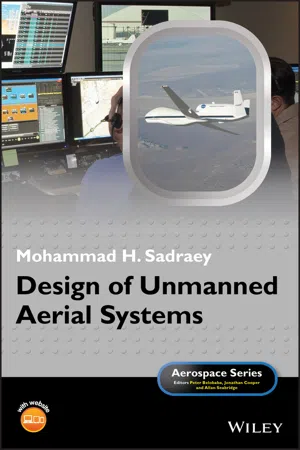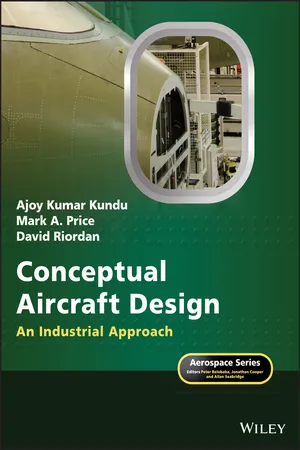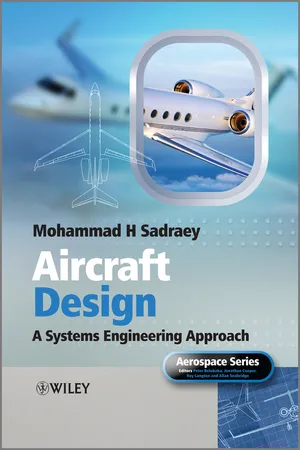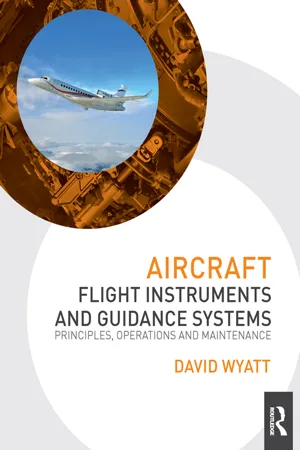Technology & Engineering
Wing Aerodynamics
Wing aerodynamics refers to the study of the airflow around and over an aircraft's wings. It involves understanding how air pressure, velocity, and density affect lift, drag, and other aerodynamic forces. Engineers use this knowledge to design wings that optimize aircraft performance, stability, and fuel efficiency. Understanding wing aerodynamics is crucial for developing efficient and safe aircraft designs.
Written by Perlego with AI-assistance
Related key terms
Related key terms
1 of 4
Related key terms
1 of 3
4 Key excerpts on "Wing Aerodynamics"
- eBook - ePub
- Mohammad H. Sadraey, Peter Belobaba, Jonathan Cooper, Allan Seabridge(Authors)
- 2020(Publication Date)
- Wiley(Publisher)
4 Aerodynamic DesignCONTENTS- Educational Outcomes
- 4.1 Introduction
- 4.2 Fundamentals of Aerodynamics
- 4.3 Wing Design
- 4.3.1 Wing Design Procedure
- 4.3.2 Airfoil Selection/Design
- 4.3.3 Wing Design Technique
- 4.3.4 Wing Design Steps
- 4.4 Tail Design
- 4.4.1 Design Procedure
- 4.4.2 Tail Configuration
- 4.4.3 Horizontal Tail Design Technique
- 4.4.4 Tail Planform Area and Tail Arm
- 4.4.5 Tail Airfoil Section
- 4.4.6 Tail Incidence
- 4.4.7 Other Horizontal Tail Parameters
- 4.5 Vertical Tail Design
- 4.5.1 Parameters
- 4.5.2 Vertical Tail Location
- 4.5.3 Vertical Tail Moment Arm (lvt )
- 4.5.4 Planform Area (Sv )
- 4.5.5 Incidence (iv )
- 4.5.6 Other Vertical Tail Parameters
- 4.5.7 Vertical Tail Design Technique
- 4.6 Fuselage Design
- 4.6.1 Fuselage Design Fundamentals
- 4.6.2 Fuselage Aerodynamics
- 4.6.3 Autopilot Compartment
- 4.6.4 Optimum Length‐to‐Diameter Ratio
- 4.6.5 Fuselage Aerodynamics
- 4.6.6 Lofting
- 4.6.7 Fuselage Design Steps
- 4.7 Antenna
- 4.7.1 Fixed Antenna
- 4.7.2 Radar Dish Antenna
- 4.7.3 Satellite Communication Antenna
- 4.7.4 Antenna Design/Installation
- 4.8 Aerodynamic Design of Quadcopters
- 4.9 Aerodynamic Design Guidelines
- Questions
- Problems
Educational Outcomes
After study of this chapter, the reader will be able to:- Conduct wing aerodynamic design
- Conduct horizontal tail aerodynamic design
- Conduct vertical tail aerodynamic design
- Conduct fuselage aerodynamic design
- Provide aerodynamic guideline to accommodate antennas
4.1 Introduction
The aerodynamics is the science that involves the study of the behavior (i.e., dynamics) of air when confronting a moving object (e.g., Unmanned Aerial Vehicle [UAV - eBook - ePub
Conceptual Aircraft Design
An Industrial Approach
- Ajoy Kumar Kundu, Mark A. Price, David Riordan, Peter Belobaba, Jonathan Cooper, Allan Seabridge(Authors)
- 2018(Publication Date)
- Wiley(Publisher)
3 Aerodynamic Fundamentals, Definitions and Aerofoils3.1 Overview
Any object moving through air interacts with the medium at each point of the wetted (i.e. exposed) surface, creating a pressure field around the aircraft body. An important part of aircraft design is to exploit this pressure field by shaping its geometry to arrive at the desired performance of the vehicle, for example, shaping to generate lifting surfaces, to accommodate payload, to house a suitable engine in the nacelle and to tailor control surfaces. This chapter is concerned with the aerodynamic information required at the conceptual design stage of a new aircraft design project. Also, this chapter covers the necessary details of one of the most important geometries concerning aircraft design, the aerofoil.Aeronautical engineering schools offer a series of aerodynamic courses, starting with the fundamentals and progressing towards the cutting edge. It is assumed that readers of this book have been exposed to aerodynamic fundamentals. Presented herein is a brief compilation of applied aerodynamics without detailed theory beyond what is necessary. Many excellent textbooks are available in the public domain for reference. Because the subject is so mature, some almost half‐century‐old introductory aerodynamics books still serve the purpose of this course; however, more recent books relate better to current examples. The information in this chapter and carried to the next chapters is essential for designers and must be understood. It is recommended that the readers go through Chapters 3 , 4 , 5 , 6 , 7 - eBook - ePub
Aircraft Design
A Systems Engineering Approach
- Mohammad H. Sadraey, Peter Belobaba, Jonathan Cooper, Roy Langton, Allan Seabridge(Authors)
- 2012(Publication Date)
- Wiley(Publisher)
Chapter 5 Wing Design5.1 Introduction
In Chapter 4, aircraft preliminary design—the second step in the design process—was introduced. Three parameters were determined during preliminary design, namely: aircraft maximum take-off weight (WTO ), engine power (P) or engine thrust (T), and wing reference area (Sref ). The third step in the design process is the detail design. During detail design, major aircraft components such as the wing, fuselage, horizontal tail, vertical tail, propulsion system, landing gear, and control surfaces are designed one by one. Each aircraft component is designed as an individual entity at this step, but in later design steps, they are integrated as one system—aircraft and their interactions are considered.This chapter focuses on the detail design of the wing. The wing may be considered as the most important component of an aircraft, since a fixed-wing aircraft is not able to fly without it. Since the wing geometry and its features influence all other aircraft components, we begin the detail design process with wing design. The primary function of the wing is to generate sufficient lift force or simply lift (L). However, the wing has two other productions, namely the drag force or drag (D) and nose-down pitching moment (M). While a wing designer is looking to maximize the lift, the other two (drag and pitching moment) must be minimized. In fact, a wing is considered as a lifting surface where lift is produced due to the pressure difference between the lower and upper surfaces. Aerodynamics textbooks are a good source to consult for information about mathematical techniques to calculate the pressure distribution over the wing and for determining the flow variables.Basically, the principles and methodologies of systems engineering are followed in the wing design process. Limiting factors in the wing design approach originate from design requirements such as performance requirements, stability and control requirements, producibility requirements, operational requirements, cost, and flight safety. Major performance requirements include stall speed, maximum speed, take-off run, range, and endurance. Primary stability and control requirements include lateral-directional static stability, lateral-directional dynamic stability, and aircraft controllability during probable wing stall. - eBook - ePub
Aircraft Flight Instruments and Guidance Systems
Principles, Operations and Maintenance
- David Wyatt(Author)
- 2014(Publication Date)
- Routledge(Publisher)
7Aeroplane aerodynamicsThis chapter serves as an introduction to aerodynamics and theory of flight for subsonic aeroplanes to underpin the study of autopilots and flight guidance systems. By EASA’s definition, ‘aeroplane’ means an engine-driven fixed-wing aircraft heavier than air that is supported in flight by the dynamic reaction of the air against its wings. The study of elementary flight theory in this chapter will be of interest for all aircraft engineers, no matter what their trade specialization. In particular, there is a need for engineers to understand how aircraft produce lift and how they are controlled and stabilized for flight. This knowledge will then assist engineers with their future understanding of autopilot and control systems and the importance of the design features that are needed to stabilize aircraft during all phases of flight. The requisite knowledge needed for the successful study and completion of basic aerodynamics, as laid down in Module 8 of EASA’s Part 66 syllabus, is addressed by another title in this book series, Aircraft Engineering Principles . Full coverage of aircraft flight control, control devices and high-speed flight theory will be found in another book in the series, Aircraft Aerodynamics, Flight Control and Airframe Structures .Our study of aerodynamics is based on the important topics covered previously in Chapter 1 , including the nature and purpose of the international standard atmosphere (ISA).This chapter also draws on knowledge of fluids in motion for the effects of airflow over aircraft and the underlying physical principles that account for the creation of aircraft lift and drag.STATIC AND DYNAMIC PRESSURE
Overview
Fluid in steady motion has both static pressure energy and dynamic pressure energy (kinetic energy) due to the motion. Bernoulli’s equation showed that for an ideal fluid, the total energy in a steady streamline flow remains constant.
Index pages curate the most relevant extracts from our library of academic textbooks. They’ve been created using an in-house natural language model (NLM), each adding context and meaning to key research topics.
Explore more topic indexes
Explore more topic indexes
1 of 6
Explore more topic indexes
1 of 4



